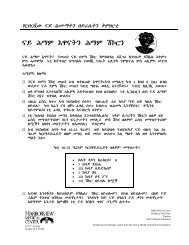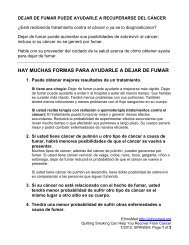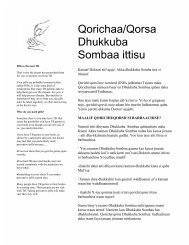Somali Knowledge Attitude Practices Study (KAPS) - EthnoMed
Somali Knowledge Attitude Practices Study (KAPS) - EthnoMed
Somali Knowledge Attitude Practices Study (KAPS) - EthnoMed
Create successful ePaper yourself
Turn your PDF publications into a flip-book with our unique Google optimized e-Paper software.
member of each data collection team monitored each data collection session and pointed out what<br />
was omitted or needed clarification.<br />
Challenges in Data Collection<br />
In the process of data collection, <strong>KAPS</strong> experienced a few challenges that included the following,<br />
time of data collection (Ramadhan period) when the population was fasting and hence basically<br />
inactive during the day meant that some respondents were not able to sit through a full interview<br />
session (a challenge that was surmounted by use of phased data collection format, i.e.,<br />
interviewing different but matching groups to complete question guide, in some areas it was<br />
difficult to get female respondents due to commitment to Ramadhan related activities; such as<br />
preparations for “Futur:, data collection days were less than initially planned in most regions due<br />
change in flight schedules and the fact that working hours were affected by Ramadhan., (in some<br />
areas data collection period was further shortened by delay in getting security clearance for<br />
vehicles), due to the rapid nature of the KAP study that was further complicated by the current<br />
insecurity situation in the country recruitment of respondents was done on the spot in some of the<br />
areas, the 48-hour UN security clearance requirement limited areas that the consultants and UN<br />
counterparts could visit while requirement of movement in pairs limited their movement, the level<br />
of English language skills was low among some of the enumerators but it was ensured that the<br />
moderator and recorder in each team had adequate language skills, poor road systems were a<br />
factor in the selection of data collection sites. Due to this challenge, inclusion of communities<br />
living in very remote areas was limited.<br />
Information analysis<br />
Considering that almost all the information gathered was qualitative in nature, componential and<br />
taxonomic analysis were mainly performed; which involved transformation of information into<br />
thematic components and then written-up descriptive prose. The data obtained from rapid<br />
profiling was coded and presented in quantitative formats while proportion piling allowed for<br />
presentation of respondents’ quantitative visual perception for varied indicators. The indicators<br />
are listed in Box 2 (Appendix 1).<br />
15






